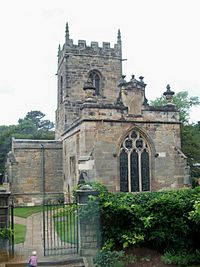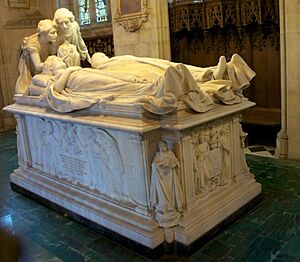All Saints Church, Kedleston facts for kids
Quick facts for kids All Saints' Church, Kedleston |
|
|---|---|

All Saints' Church, Kedleston, from the east
|
|
| Lua error in Module:Location_map at line 420: attempt to index field 'wikibase' (a nil value). | |
| OS grid reference | SK 312 403 |
| Location | Adjacent to Kedleston Hall, Derbyshire |
| Country | England |
| Denomination | Anglican |
| Website | Churches Conservation Trust |
| History | |
| Dedication | All Saints |
| Architecture | |
| Functional status | Redundant |
| Heritage designation | Grade I |
| Designated | 13 February 1967 |
| Architectural type | Church |
| Style | Norman, Gothic |
| Groundbreaking | 12th century |
| Completed | 1908 |
| Specifications | |
| Materials | Sandstone, Welsh slate roofs |
All Saints' Church, Kedleston, is an old Anglican church near Derby in Derbyshire, England. It is no longer used for regular church services. This church is the only part left of the old medieval village of Kedleston. The village was taken down in 1759 by Nathaniel Curzon. He wanted to build the large country house called Kedleston Hall nearby.
All Saints' Church is a very important historical building. It is listed as a Grade I building in the National Heritage List for England. This means it has special historical or architectural importance. Kedleston Hall is now looked after by the National Trust. The church is cared for by the Churches Conservation Trust. The Curzon family has lived at Kedleston Hall for over 700 years.
Contents
History of All Saints' Church
The village of Kedleston was mentioned in the Domesday Book. This was a big survey of England made in 1086. The church was first written about in 1198–99. The oldest part of the church is the south doorway. It was built in the Norman style. Most of the church you see today was rebuilt in the 1200s.
Changes Over the Centuries
Between 1480 and 1510, the top of the church tower was rebuilt. This was done in the Perpendicular style. This style has tall, thin windows and detailed stone carvings. From 1700 to 1720, some decorations were added. These included stone vases and a sundial on the east side.
In 1759, work began on the current Kedleston Hall. The old village of Kedleston was removed to create a large park around the new house. In 1884–85, a big repair project happened. This was led by John Oldrid Scott. The roof was made higher, and a new wooden ceiling was put in. A new window was added on the west side. The old wooden box pews were also taken out of the main part of the church.
In 1908, Lord George Curzon added the Kedleston Chapel. This chapel is on the north side of the church. It was built as a memorial to his wife, Mary. She had passed away earlier. The chapel was designed by G. F. Bodley.
Recent History of the Church
Between 1910 and 1912, the stained glass windows were replaced. Some new stained glass was also added. The church stopped being used for regular services on April 1, 1983. It was then given to the Churches Conservation Trust in 1989. Today, two people look after the church. They make sure it is cared for and protected when it is open to visitors.
Church Architecture
The church is built from sandstone with roofs made of Welsh slate. It has a cross-shaped layout. There is a tower in the middle, where the arms of the cross meet. It has a main area called the nave, and the Kedleston Chapel on the north side. There are also north and south transepts (the arms of the cross). The chancel is at the east end, and a small room called a vestry is on the north side.
Exterior Features
The south doorway is in the old Norman style. It has a round arch with a zigzag pattern. Inside the arch is a stone panel called a tympanum. It has old carvings of animals that are now hard to see. To the right of the door are two windows, each with two lights. Each transept has strong supports called buttresses. They also have a window with three tall, narrow lancet windows.
On the south wall of the chancel, there is a door for the priest. Next to it is a lancet window. The upper part of the chancel, called the clerestory, has two-light windows. The east wall has diagonal buttresses. It also has a window with three lights. Above this is a low wall called a parapet. In the middle of the parapet is a sundial. It has the words "We shall" and carvings of skulls. At the ends of the parapet are decorative stone shapes called urn finials.
The Kedleston Chapel has three sections, separated by buttresses. Each section has a three-light window. Below these windows are three small, clover-shaped openings. These act as vents. Along the top of the chapel's parapet is a Latin inscription. It says "QUIA MULTUM AMAVIT," which means "Because she loved much." The west wall has diagonal buttresses and a three-light window. Above this is a lancet window in the gable (the triangular part of the wall).
The tower has two main levels. The lower level has two lancet windows. The upper level has two-light openings for the bells on each side. The very top of the tower has a battlemented parapet. This looks like the top of a castle wall. At the corners are pointed decorations called crocketted pinnacles.
Interior Features
Inside the church, there is a row of arches called an arcade. This separates the nave from the Kedleston Chapel. In the chancel, there is a small cupboard called an aumbry and a basin called a piscina. Another piscina is in the south transept. The north transept holds the church organ.
The font is from the 1700s. It has a round bowl on a many-sided base. It also has a wooden cover. The wooden pulpit (where sermons are given) is from the 1800s. The brass lectern, shaped like an eagle, was made in 1886. The chancel has old-fashioned box pews. The altar is in the Jacobean style. There is a beautiful wrought iron screen with gates in the arcade. The church also has wrought iron light fittings and a large circular chandelier called a corona lucis. There are five hatchments, which are painted shields showing family coats of arms.
Some of the stained glass in the chancel windows is very old, from the 1600s. It was moved into the church in 1910. Other stained glass is from the late 1800s and early 1900s. The organ has two manuals (keyboards). It was built in 1899 and later made bigger in 1910.

The church has 35 monuments to the Curzon family. These include large tombs, wall plaques, and floor tablets. They date from the 1200s to the 1900s. The biggest tomb is in the Kedleston Chapel. It has stone figures, called effigies, of the 1st Marquess Curzon of Kedleston (who passed away in 1925) and his first wife, Mary. The chapel was built for Mary, who passed away in 1906 at age 36. This tomb is made of white marble. Two angels are shown leaning over the figures, holding a crown. The memorial was designed by Sir Bertram Mackennal.
In the south transept, there is another tomb with figures of Sir John Curzon and his wife from 1456. Sir John is shown wearing armor. At their feet are dogs. On the sides of the tomb are figures of their 17 children. Also in this transept is a simple stone slab with a cross and leaves. It remembers Thomas de Curzon, who passed away in 1245. There are also wall memorials for Sir John Curzon, 1st Baronet (who passed away in 1686) and his wife, Patience (who passed away in 1642). Another is for Sir John Curzon, 3rd Baronet, who passed away in 1727.
More memorials are found in the north transept. One was designed by Peter Scheemakers. It remembers Sir Nathaniel Curzon, 2nd Baronet (who passed away in 1719) and his wife Sarah. Another memorial is for Sir Nathaniel Curzon, 4th Baronet and his family. It dates from 1758 and was made by Michael Rysbrack. The design was by Robert Adam.
Outside the Church
The churchyard has war graves. These are for a Derbyshire Yeomanry officer (who was a member of the Curzon family) and a Pioneer Corps soldier. Both passed away during World War II.
See also
- Grade I listed churches in Derbyshire
- Grade I listed buildings in Derbyshire
- Listed buildings in Kedleston
- List of churches preserved by the Churches Conservation Trust in the English Midlands

